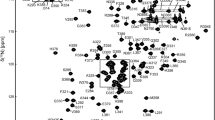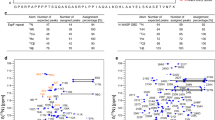Abstract
In eubacteria, the formyl group of nascent polypeptides is removed by peptide deformylase protein (PDF). This is the reason why PDF has received special attention in the course of the search for new antibacterial agents. We observed by NMR that actinonin, a natural inhibitor, induced drastic changes in the HSQC spectrum of E. coli PDF. We report here the complete NMR chemical shift assignments of PDF resonances bound to actinonin.


Similar content being viewed by others
References
Boularot A, Giglione C, Artaud I et al (2004) Structure–activity relationship analysis and therapeutic potential of peptide deformylase inhibitors. Curr Opin Investig Drugs 8:809–822
Boularot A, Giglione C, Petit S et al (2007) Discovery and refinement of a new structural class of potent peptide deformylase inhibitors. J Med Chem 50:10–20. doi:10.1021/jm060910c
Chen DZ, Patel DV, Hackbarth CJ et al (2000) Actinonin, a naturally occurring antibacterial agent, is a potent deformylase inhibitor. Biochemistry 39:1256–1262. doi:10.1021/bi992245y
Dardel F, Ragusa S, Lazennec C et al (1998) Solution structure of nickel-peptide deformylase. J Mol Biol 280:501–513. doi:10.1006/jmbi.1998.1882
Delaglio F, Grzesiek S, Vuister GW et al (1995) NMRPipe: a multidimensional spectral processing system based on UNIX pipes. J Biomol NMR 6:277–293. doi:10.1007/BF00197809
Giglione C, Pierre M, Meinnel T (2000) Peptide deformylase as a target for new generation, broad spectrum antimicrobial agents. Mol Microbiol 36:1197–1205. doi:10.1046/j.1365-2958.2000.01908.x
Goddard TD, Kneller DG. SPARKY 3. University of California, San Francisco
Guilloteau JP, Mathieu M, Giglione C et al (2002) The crystal structures of four peptide deformylases bound to the antibiotic actinonin reveal two distinct types: a platform for the structure-based design of antibacterial agents. J Mol Biol 5:951–962. doi:10.1016/S0022-2836(02)00549-1
Meinnel T, Blanquet S, Dardel F (1996) A new subclass of the zinc metalloproteases superfamily revealed by the solution structure of peptide deformylase. J Mol Biol 262:375–386. doi:10.1006/jmbi.1996.0521
Petit S, Duroc Y, Larue V et al (2008) Structure-activity relationship analysis of the peptide deformylase inhibitor 5-bromo-1H-indole-3-acetohydroxamic acid. Chem Med Chem 4:261–275. doi:10.1002/cmdc.200800251
Acknowledgments
This work was supported by the Centre National de la Recherche Scientifique (CNRS, France), and grant ANR-06-MIME-010 from the Agence Nationale de la Recherche (ANR, France).
Author information
Authors and Affiliations
Corresponding author
Rights and permissions
About this article
Cite this article
Larue, V., Seijo, B., Tisne, C. et al. 1H, 13C and 15N NMR assignments of the E. coli peptide deformylase in complex with a natural inhibitor called actinonin. Biomol NMR Assign 3, 153–155 (2009). https://doi.org/10.1007/s12104-009-9164-6
Received:
Accepted:
Published:
Issue Date:
DOI: https://doi.org/10.1007/s12104-009-9164-6




